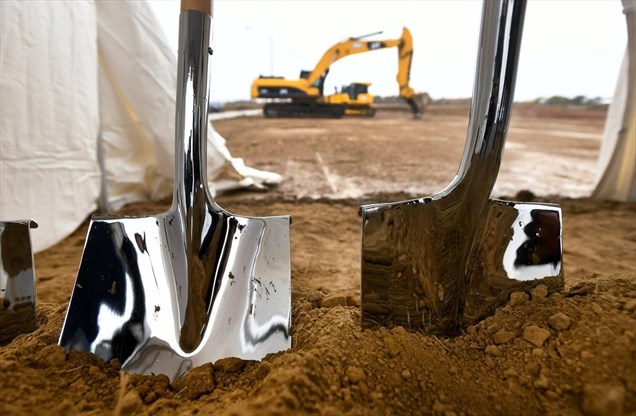Panattoni project marks major milestone in city’s vision for an Airport Employment Growth District
By Tom Hogue The Hamilton Spectator
Tom Hogue is a feature writer and video producer who regularly contributes to the business section of thespec.com and The Hamilton Spectator. He is a recipient of a Western Magazine Award, Ontario Newspaper Awards and was nominated for a National Magazine Award.
Email: thogue@thespec.com
A long-stalled chunk of industrial land next to Hamilton airport is finally ready for takeoff.
Developer Panattoni officially broke ground Tuesday on a $30-million warehouse it will build even though there is no tenant for the 264,535-square-foot space at 50 Aeropark Blvd.
It’s a “speculative” investment, but not the first for the privately held property giant that has 320 million square feet of space across North America and Britain and a Rolodex of clients that includes Coca-Cola, Canadian Tire and Adidas.
“We’re building it without a tenant because we’ve got confidence in the marketplace, we’ve got confidence in the city,” said Panattoni executive vice-president Michael Smele, who noted that 80 per cent of its projects start with a similar build-it-and-they-will-come strategy.
Hamilton Mayor Fred Eisenberger marked the moment as a major milestone in the city’s vision for an Airport Employment Growth District.
“Your investment is why these lands are here — to provide employment for the future,” Eisenberger said.
Panattoni bought the 82-acre Aeropark site near Upper James Street and Dickenson Road West last year for $27 million with the intention of developing 1.6 million square feet in stages.
The first building is expected to be ready for occupancy in the fall of 2020 as a single warehouse with 44 truck bays or divided up into offices for as many as 200 staff.
Meanwhile, the next Aeropark building is expected to be four times the size of the first at more than 1 million square feet, and will be built in two phases.
“Through the fence” opportunities exist for developers such as Panattoni to negotiate direct access to the airport to serve cargo jets, said Cathie Puckering, CEO of John. C. Munro Hamilton International Airport.
The move would expand Hamilton’s cargo service, which climbed to 525,161 kilograms in 2018 from 438,924 kilograms two years earlier.
Though Panattoni is just beginning to develop the 82-acre site, the company is nonetheless buying other property nearby. Smele announced Tuesday that the company is purchasing a 90-acre parcel of land across Dickenson in a $17-million deal expected to close in mid-November.
An unnamed developer is also expected to close a deal in January to buy 140 acres next door on Dickenson, according to Guy Paparella, director of growth planning for the city’s Economic Development Department.
“There’s a lot of activity right now and it’s not just this site — all the big developers are here,” said Paparella, who has been working for more than a decade to bring about an Airport Employment Growth District to the area bordered by Garner Road East, Twenty Road, Upper James Street and Highway 6.
“There’s no land left in Toronto or any other airport in the area. Waterloo’s too small, London’s too far away, so we’re it,” Paparella said of a busy year for the AEGD that is about to get busier.
Getting the AEGD to this point was at times a bumpy flight, including an Ontario Municipal Board dispute that ended in 2015 with the approval of the 1,360-acre boundary push — the largest expansion in Hamilton’s history.
The next piece of the puzzle is managing truck traffic along Dickenson and around the new warehouse complex, where roughly six million square feet of development is planned between Panattoni and the unidentified developer next door.
To keep trucks off Upper James, an environmental assessment is underway to expand Dickenson to four lanes from two and extend it past Glancaster Road on a new, direct road to Book Road and the Highway 6 bypass.
